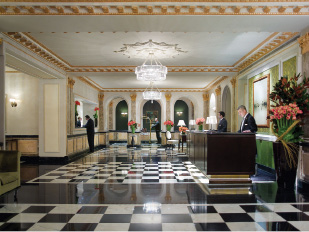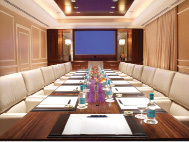- Home
- Media Kit
- Current Issue
- Past Issues
- Ad Specs-Submission
- Ad Print Settings
- Reprints (PDF)
- Photo Specifications (PDF)
- Contact Us

![]()
ONLINE

Under the Taj Flag
Editors’ Note
Heiko Kuenstle assumed his current post as General Manager at The Pierre in 2005. Kuenstle spent four years at this landmark hotel on New York’s Fifth Avenue earlier in his hospitality career. Previously, he was General Manager at The Lowell Hotel, New York, beginning in June 2001. He began his career in Germany where he apprenticed at the three-star Michelin restaurant, Schwarzwaldstube, oversaw the one-star Michelin restaurant at Moenchs Posthotel, and served as Manager of Hotel Domizil. Kuenstle began at The Pierre in 1994 as Assistant Manager in housekeeping and rose to Guest Service Manager and Front Office Manager before leaving for the Hôtel Plaza Athénée, New York where he served as Rooms Division Manager. From 2001 to 2005, he was General Manager of The Lowell Hotel, New York.
Property Brief
The Pierre is situated on Central Park at Fifth Avenue and 61st Street. It was built in 1929 in the style of a French chateau, and in 1938, J. Paul Getty acquired the hotel and subsequently sold some of the property’s original 700 guest rooms as cooperative apartments. Operations changed hands several times until Trust House Forte acquired the hotel in 1973. The lease was taken over by Four Seasons Hotels and Resorts in 1981. Taj Hotels Resorts and Palaces is the current lessee and operator of The Pierre (www.tajhotels.com/pierre).
Established in 1903, Taj Hotels Resorts and Palaces is one of Asia’s largest and finest groups of hotels, comprising 56 hotels in 39 locations across India with an additional 17 international hotels in the Maldives, Malaysia, U.K., U.S., Bhutan, Sri Lanka, Africa, and the Middle East. The Indian Hotels Company Ltd. (IHCL) operates Taj Hotels Resorts and Palaces, which is part of the Tata Group.
Many are concerned about the recession’s impact on rates as well as occupancy. How much of an impact did you see for The Pierre and have you seen the New York market coming back?
We were out of the market for a while with a renovation. We reopened in October 2009, so I have a year of comparable data.
We have improved our position in the New York market with a much better product under the Taj flag.
Everybody expected the rates to be higher when we reopened, but realized there was a market correction. As clearly as the recession started in New York with the financial industry, it’s also clear that it’s having the quickest recovery.
The industry has gone through a tough year if you look at revenues and rates, but there is a steady, albeit cautious, rebound.
There is still a rate game going on and people feel they are entitled to special rates because of the economic circumstances. But hotels are starting to realize they don’t have to discount as much any more and that is reassuring.

The Pierre Lobby
You have a very strong suite offering. Is there a consistent feel suite to suite or are you offering different designs throughout?
Very different, especially in our Grand suites, which are a reflection of residential-style living at the hotel. The Charles Pierre Suite, for example, was done in a stark contemporary design by Italian architect Piero Lissoni, which is certainly not The Pierre as people knew it. It is one of our Grand Suites that features a beautiful terrace and people love the idea that there is something unexpected about it now.
So, the 11 Grand Suites are completely distinct in their design and layout. Another one reflects a very Indian design; the others have a more traditional feel, but they are all different.
Hoteliers in New York City talk about the challenge in food and beverage. Have you been happy with the partnership in that area and how it has been received?
I’m very happy to have a name restaurant associated with The Pierre, because it strengthens both brands.
When we closed the hotel, we knew it was the end of Café Pierre and that we were at a crossroads – we had to decide if we were going with a three-star Michelin concept or a restaurant that could appeal to a broader group of guests/patrons.
I wanted to have a restaurant in this neighborhood where people feel comfortable to come in for breakfast, lunch, or dinner several times a week. With our partnership with Le Caprice, we found an upscale brasserie concept – and the English heritage is unique.
It fit a perfect niche in this market and it’s a great value concept compared to most hotel restaurants.

High-Tech Boardroom
What are your offerings in terms of meeting and event space?
One of the core strengths of this hotel is its event space, because the flow of the rooms is ideal for many different events, whether it’s social or corporate.
During the renovation, we built several smaller meeting spaces and a boardroom that has all the appropriate technology and clearly fills a niche that we couldn’t appropriately accommodate before. It enables us to go after small executive and boardroom meetings, which also drive a lot of suite occupancy. This is very crucial for us with almost 25 percent of our inventory being suites.
How much value has the Taj banner brought to the property and was it challenging to mesh the cultures?
Through Taj’s almost 110-year history, its origins and deep roots have been in India, but we are growing in leaps and bounds all over the world. We just opened in Cape Town, South Africa. One shouldn’t define Taj as an Indian company – it’s a world-class luxury hotel operator.
The hotel was managed by Four Seasons for over 25 years. That left a deep impression on the hotel and on the workforce as well. So there had to be a reorientation from the philosophies of Four Seasons to the philosophies of Taj, but all of that has happened in a positive way.
Also, The Pierre itself has such a strong identity as a brand that, even after 25 years of Four Seasons, there were lots of people who never realized it was a Four Seasons. That is currently true for Taj as well, to an extent.
After Taj invested more than $100 million into this building, the result is a very elegant European-style hotel with subtle Indian touches. You want a hotel to have a sense of location, which was accomplished very well with the renovation because guests still recognize The Pierre and love all the improvements.
Taj has adopted the Tata Business Excellence Model, and we are implementing a lot of processes and systems that will enable us to enhance the service product by making it far more consistent.
We’re also starting to see the benefit of being a part of the Tata conglomerate. Tata already has a worldwide presence and we have really just started to capitalize on the opportunities here.•